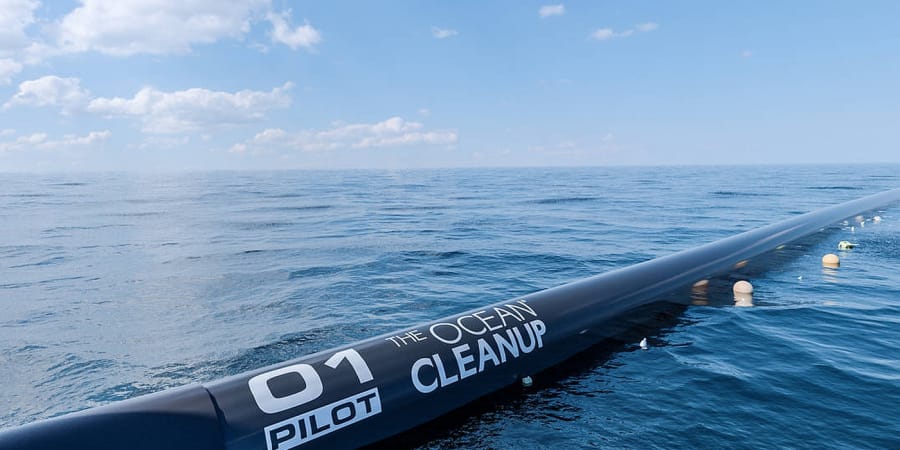Already today around 80,000 tons of plastic are estimated to be in the “Great Pacific Garbage Patch” between California and Hawaii and the number is steadily increasing (Briggs, 2018). Besides the “Great Pacific Garbage Patch” there are other patches in the Atlantic and Indian Ocean as well. These patches can be understood as massive swirling vortexes which trap huge collections of waste in their currents. The size of the Great Pacific Garbage Patch alone is estimated to be three times the size of Spain (Loria, 2018). If the plastic is left where it is, it can have substantial negative effects on our ecosystem, health and economies. All this is caused by us, our enormous plastic consumption and non-considerate waste disposal.
But luckily, an initiative has been started in 2013 by a Dutch student from Delft, Boyan Slat, called “The Ocean Cleanup” which aims at cleaning up the oceans (as the name suggests). Currently a team of more than 70 people consisting of engineers, researchers, scientists and computational modelers are working on bringing this project live. They are building a system which is able to extract huge amounts of plastic from the patches by firstly capturing, then accumulating and finally extracting the plastic out of the oceans. The complete technology relies on algorithms that specify the optimal deployment position of the clean-up system and takes advantage of the natural forces of the ocean. For a complete description of how the system functions please click here. On September 9th 2018, it was announced that the first clean-up system was launched and is now on its way to an intermediary test stop, 250-350 nautical miles offshore, for a 2-week trial until it begins to free the Great Pacific Garbage Patch from its garbage.
As happy as I am to hear that technologies nowadays can be developed that can make up for human mistakes, I am afraid that we are taking on a mentality that future advances can make up for anything. I see this problem arising not only in the field of waste disposal but also in areas like our health or love life. Will we soon not listen to our body anymore but rather rely on wearables telling us when what to eat and when to exercise? And then, if we do not listen to those wearables, will we just trust in other technologies fixing our health afterwards? The same could potentially become true for our love lives, where we rather listen to AI predictions of how likely someone fits to us than to our own feelings. What is your impression – are such advances rather a blessing or a curse?
References:
Briggs, H., 2018. Plastic patch in Pacific Ocean growing rapidly, study shows. BBC News. Available at: https://www.bbc.com/news/science-environment-43490235 [Accessed September 18, 2018].
Loria, K., 2018. The giant garbage vortex in the Pacific Ocean is over twice the size of Texas – here’s what it looks like. Business Insider. Available at: https://www.businessinsider.nl/great-pacific-garbage-patch-view-study-plastic-2018-3/?international=true&r=US [Accessed September 18, 2018].
The Ocean Cleanup, www.theoceancleanup.com. The Ocean Cleanup. Available at: https://www.theoceancleanup.com/ [Accessed September 18, 2018].


Thank you for this post, Theresa! Very interesting, concurrent and inspiring initiative you outlined and I share some of your concern. As described, technologies these days tend to suck people into the fairly unconstrained online world, for good and worse. An extensive amount of studies confirm the substansive influence of technology on the behavior of people.
In 2008, a study on students found that 85 percent of undergraduates surveyed used social networking sites (Salaway et. al, 2008) My guess would be that the 85 percent stated has boomed near 100 percent today. Salaway, Caruso and Nelson also mentioned in the article ‘Technology can have positive and negative impact on social interactions’ that some technological advances cause people to be distracted, overly stressed, and increasingly isolated (2008). Debates about whether Internet addictions are real or not are totally unnecessary as this has been extensively proven. To get back to your fear of IT taking part in our love life; assertions have been made that dating web sites contribute significantly to cheating on one’s significant other, potentially leading to a divorce. People have been put under greater pressure because the use of these sites at work or because certain posts that undermined the person’s professional standing (Bess, 2018). On the other hand, people from different cultures, backgrounds and geographic places can connect with one another like never before. Instant connection between people as well as plenty of other opportunities made possible by IT can be considered a blessing.
The more we start living through screens, the more we are living in a narrow, controllable, and abstract world that is increasingly artificial and unrealistic. The threat of losing connection to reality altogether is something I consider as a worry too.
All in all, I believe that today’s technologies are an absolute blessing if being used consciously and purposefully. The technology curse activates as soon as people tend to forget where they are created for in the first place; to assist the human kind evolve!
P.s. there are various interesting TEDx talks on this matter, you might want to check out this one for example: https://www.youtube.com/watch?v=VxuWIXdYYyQ
https://uk.humankinetics.com/blogs/excerpts/technology-can-have-positive-and-negative-impact-on-social-interactions
https://www.vox.com/technology/2018/2/23/16992816/facebook-twitter-tech-artificial-intelligence-crispr